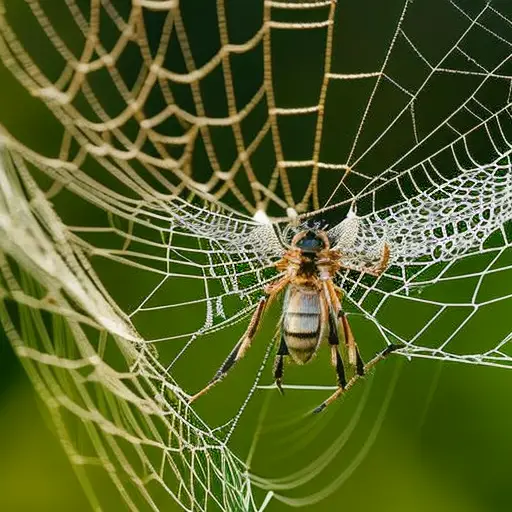How to Protect Your Food From Wildlife

Are you tired of wildlife infiltrating your food storage and causing havoc? Look no further! In this informative article, we will guide you through practical ways to protect your food from cunning critters.
From securing trash cans to utilizing scent deterrents, we have all the scientific solutions you need.
Join us as we explore the world of wildlife-proofing, ensuring your food remains safe and untouched.
Get ready to say goodbye to those pesky intruders once and for all!
Securing Trash Cans
To prevent wildlife from accessing your trash cans, secure them with sturdy lids and fasten them tightly with bungee cords or padlocks. Trash can maintenance plays a crucial role in wildlife proofing techniques, as improperly secured trash cans can attract animals searching for food. Wildlife, such as raccoons, bears, and squirrels, are known to be opportunistic feeders and can easily tear through weak or loose lids. Therefore, it is important to regularly inspect and maintain the trash cans to ensure they are secure and free from any potential openings.
One effective method is to use bungee cords to tightly secure the lids. This will prevent wildlife from easily lifting or removing the lids. Another option is to use padlocks, which provide an additional layer of security. It is recommended to choose durable and heavy-duty trash cans with sturdy lids to deter wildlife from attempting to access the contents.
Regularly cleaning the trash cans is also essential in wildlife proofing. Food residue or odors can attract animals, so it is advisable to rinse the cans with water and a mild detergent to eliminate any lingering smells. Additionally, storing the trash cans in a secure location, such as a shed or garage, can further prevent wildlife access.
Installing Wildlife-Proof Fencing
To further enhance the protection of your food from wildlife, consider installing wildlife-proof fencing around your property. Wildlife-proof barriers are an effective way to keep animals from accessing your food sources, preventing potential damage and loss. Here are some key benefits and considerations to keep in mind when installing wildlife-proof fencing:
-
Enhanced security: Wildlife-proof fencing provides a physical barrier that deters animals from accessing your property, ensuring the safety of your food. The sturdy construction and design of these fences make them difficult for wildlife to breach.
-
Customizable options: Wildlife-proof fencing comes in various materials, heights, and designs, allowing you to choose the most suitable option for your specific needs. The type of wildlife in your area and their typical behavior will help determine the best fencing solution.
-
Durability and longevity: Investing in high-quality wildlife-proof fencing ensures that it will withstand the elements and last for many years. Look for fencing materials that are resistant to corrosion, weathering, and animal damage.
When installing wildlife-proof fencing, it is also essential to consider alternative food storage options. By properly storing your food in secure containers or refrigerated areas, you can minimize the attraction of wildlife to your property. Remember to regularly inspect and maintain your fencing to ensure its effectiveness in protecting your food from wildlife intrusion.
Using Scent Deterrents
Scent deterrents can be an effective way to protect your food from wildlife. There are various wildlife repellent options available that utilize strong odors to deter animals from approaching your food.
These scents can range from predator urine to strong herbal fragrances, which can confuse and repel wildlife, preventing them from accessing your food source.
Effective Scent Deterrents
Using scent deterrents is an effective method for protecting your food from wildlife. By understanding wildlife behavior and utilizing natural repellents, you can create an environment that discourages animals from accessing your food.
Here are three sub-lists that highlight the effectiveness of scent deterrents:
-
Understanding wildlife behavior: Animals rely heavily on their sense of smell to locate food. By utilizing scent deterrents, you can disrupt their ability to locate and access your food source.
-
Natural repellents: Certain scents, such as predator urine or strong spices like cayenne pepper, can act as natural repellents for wildlife. These scents are unpleasant to animals and can deter them from approaching your food.
-
Creating a barrier: By strategically placing scent deterrents around your food storage area, you can create a barrier that animals are reluctant to cross. This barrier will help protect your food from wildlife.
Understanding the effectiveness of scent deterrents is crucial when considering wildlife repellent options. By incorporating these methods, you can effectively safeguard your food from unwanted animal visitors.
Wildlife Repellent Options
When considering how to protect your food from wildlife, one effective option to consider is utilizing various wildlife repellent options that rely on scent deterrents. These repellents work by emitting strong odors that are unpleasant to wildlife, making them less likely to approach and damage your food. The effectiveness of wildlife repellents can vary depending on the specific product and the type of wildlife you are dealing with.
However, natural wildlife repellents, such as those made from predator urine or essential oils, have shown promising results in deterring animals like deer, rabbits, and squirrels. It is important to note that repellent effectiveness may also be influenced by factors such as weather conditions and the persistence of the scent.
In the next section, we will explore another effective method for protecting your food from wildlife: storing it in airtight containers.
Storing Food in Airtight Containers
To effectively protect your food from wildlife, it is essential to store it in airtight containers. Proper food storage techniques can go a long way in preventing wildlife encounters and keeping your food safe. Here are some key reasons why using airtight containers is crucial:
-
Preserves freshness: Airtight containers create a barrier that prevents moisture, air, and other contaminants from entering, preserving the freshness and quality of your food for longer periods.
-
Prevents odors: Wildlife have keen senses of smell and are attracted to the scent of food. Airtight containers seal in odors, reducing the chances of attracting unwanted visitors.
-
Minimizes spills and mess: Airtight containers prevent food from spilling or leaking, reducing the chances of wildlife being enticed by food remnants.
By storing your food in airtight containers, you significantly decrease the likelihood of wildlife encounters and the risk of your food being consumed or contaminated. However, it is important to note that while airtight containers are effective, they should be used in conjunction with other wildlife repellent options for maximum protection.
Now that we have covered the importance of storing food in airtight containers, let’s explore the next section on implementing sound and light repellents to further safeguard your food from wildlife.
Implementing Sound and Light Repellents
When it comes to protecting your food from wildlife, implementing sound and light repellents can be an effective strategy.
The effectiveness of noise deterrents will depend on the specific species of wildlife you are dealing with, as different animals may have different responses to certain sounds.
Additionally, there are various options for light repellents that can be used, such as motion-activated lights or strobe lights, which can disrupt wildlife and discourage them from approaching your food.
Noise Deterrent Effectiveness
Implementing sound and light repellents can effectively deter wildlife from accessing and damaging your food. Noise deterrent research has shown that animals are sensitive to certain sounds, making them less likely to approach areas where these sounds are present.
When it comes to using noise as a deterrent, there are several alternative noise options to consider:
-
Ultrasonic devices: Emitting high-frequency sounds that are inaudible to humans but irritating to animals, ultrasonic devices can be effective in repelling wildlife.
-
Motion-activated sound devices: These devices produce loud noises when triggered by motion, startling and scaring away wildlife.
-
Predator sounds: Playing recordings of predator sounds, such as coyote calls or bird of prey cries, can create an intimidating environment for wildlife.
Light Repellent Options
Incorporating light repellent options into your food protection strategy can effectively deter wildlife from accessing and damaging your food. Light repellents work by creating an environment that is unattractive or uncomfortable for wildlife, making them less likely to approach your food sources. There are various types of light repellents available, including natural options that are safe for both humans and wildlife.
To better understand the effectiveness of different light repellents, consider the following table:
| Light Repellent Type | Description | Effectiveness |
|---|---|---|
| Flashing Lights | Emit bright, intermittent flashes of light | High |
| Laser Pointers | Produce a concentrated beam of light | Moderate |
| Solar-Powered LED Lights | Emit continuous light using solar energy | Low |
While flashing lights have shown to be highly effective in deterring wildlife, laser pointers and solar-powered LED lights have varying levels of effectiveness. It is important to note that some wildlife may become accustomed to certain light repellents over time, requiring periodic changes in the type or pattern of light used.
Wildlife Response Patterns
Wildlife typically exhibit predictable response patterns when exposed to sound and light repellents. Understanding these patterns can help inform effective wildlife management strategies.
Here are three sub-lists detailing some common response patterns observed in wildlife when encountering sound and light repellents:
-
Alarm and Avoidance
- Wildlife may exhibit signs of alarm, such as freezing or fleeing, upon exposure to sudden loud noises or bright lights.
- They may quickly retreat from the area where the repellents are deployed.
- Animals may become more vigilant and cautious in their behavior, avoiding areas with ongoing repellent activity.
-
Habituation and Adaptation
- Over time, wildlife may become accustomed to the presence of sound and light repellents, resulting in reduced responsiveness.
- Some animals may develop adaptive behaviors, such as adjusting their activity patterns to avoid repellent-treated areas.
- Habituation and adaptation can impact the long-term effectiveness of sound and light repellents.
-
Species-specific Variation
- Different species may exhibit varying levels of sensitivity and response to sound and light repellents.
- Factors such as natural behavior, habitat preferences, and ecological traits can influence the effectiveness of repellents.
- Wildlife managers should consider species-specific responses to tailor repellent strategies accordingly.
Understanding wildlife behavior and response patterns is crucial for effective wildlife management. By incorporating sound and light repellents strategically, it is possible to mitigate human-wildlife conflicts and protect food from wildlife intrusion.
Properly Disposing of Food Waste
- Properly disposing of food waste is a crucial step in safeguarding your food from wildlife. Not only does it help prevent unwanted animal intrusions, but it also offers numerous benefits, such as reducing food waste and promoting composting.
Composting is an effective method of disposing of food waste. It involves collecting organic materials, such as fruit and vegetable scraps, coffee grounds, and eggshells, and allowing them to decompose naturally. The resulting compost can then be used as a nutrient-rich soil amendment for plants and gardens. This practice not only reduces the amount of food waste going to landfills but also helps to enrich the soil and support sustainable gardening practices.
To further emphasize the benefits of composting and reducing food waste, let’s take a look at the following table:
| Benefits of Composting and Reducing Food Waste |
|---|
| Reduces greenhouse gas emissions |
| Saves landfill space |
| Saves money on waste disposal costs |
| Improves soil quality and fertility |
Frequently Asked Questions
What Are Some Common Types of Wildlife That Can Be a Threat to Food Security?
Common types of wildlife that can threaten food security include rodents, birds, insects, and larger animals like deer and bears. Understanding their behavior and implementing effective wildlife management strategies is crucial to mitigate the impact on agricultural crops.
How Can I Prevent Wildlife From Accessing My Compost Pile or Food Waste Bin?
To prevent wildlife from accessing your compost pile or food waste bin, natural deterrents can be used. These include fencing, motion-activated sprinklers, or planting strong-smelling plants. Alternatively, consider using alternative disposal methods such as burying food waste or using a sealed composting system.
Are There Any Natural Repellents or Plants That Can Help Deter Wildlife From Entering My Property?
Natural repellents and certain plants can be effective in deterring wildlife from entering your property. These repellents work by emitting scents or producing sounds that animals find unpleasant. Planting certain species can also create barriers that discourage wildlife from accessing your food.
Should I Be Concerned About Wildlife Spreading Diseases to My Food, and How Can I Minimize This Risk?
Minimizing the risk of wildlife diseases spreading to your food is necessary to ensure food safety. Effective methods to protect your food from wildlife encounters include proper storage, sealing containers, and using sturdy, animal-proof barriers.
Are There Any Specific Regulations or Guidelines I Should Follow When Implementing Wildlife-Proof Measures in My Area?
Regulations and guidelines for wildlife-proof measures in local areas are essential to minimize the risk of wildlife accessing and contaminating food. Legal requirements and permits may be necessary when implementing such measures to ensure compliance with wildlife protection laws.
Conclusion
In conclusion, protecting our food from wildlife is crucial to maintain our health and safety.
By securing trash cans, installing wildlife-proof fencing, using scent deterrents, storing food in airtight containers, and implementing sound and light repellents, we can effectively prevent wildlife from accessing our food.
Remember, ‘prevention is better than cure,’ so taking these practical steps will help us avoid potential conflicts with wildlife and ensure the preservation of our food.





